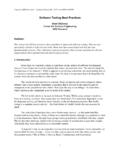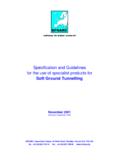Transcription of A guide to best practice - SEHAUC
1 SW HAUCA guide to best practiceThe selection, transportation,care and laying of materialsfor reinstatement worksDEC 07 Scope4 Material selection5 Road categories, Backfill and sub-baseBinder course, Surface course C/W and F/WPCSMs, Specialist surfaces etcCollection handling and transportation11 Polished stone value (PSV)Understanding a quarry ticketCollection, TransportationBackfill and compaction15 Step by step guide to:Materials, Layers and passesCompaction, Edge sealantLaying of bituminous materials22 Weather conditionsTools and equipmentUnloading, Placement Compaction, TolerancesLining and special surfacesAppendices28 Preferred layer thicknessAcknowledgements31 This best practice has been written by a SWHAUCsub group in consultation with.
2 Atkins (Somerset CC) Wessex Water Devon CC Labs Cornwall CC Openreach (a BT group business) Wales and West Utilities South West Waterand its partners Balfour Beatty andMay CATEGORIESP rior to the reinstatement of any excavation it is necessary to know whattype of materials and construction depths should be used in carrying outthe authorities place details of all roads, for which they haveresponsibility, on to the Streetworks gazetteer and classify them into oneof the following categories. This is based on the number of vehicles inexcess of tonnes that are expected to travel along the thickness of the structural layers of the reinstatement will dependon the category of the road, eg, a Type 1 road will require a greater con-struction thickness than a Type 4 road.
3 Footways, footpaths and cycletracks have their own structural layer thickness requirements. Details ofthe layer thickness requirements can be found on pages 28 and 29 BACKFILL AND SUB-BASE MATERIALSIn the lower section of an excavation a layer of fine material may beplaced around the pipe, cable or duct, this is referred to as the surroundto above the surround to apparatus are placed the backfilllayers. Material excavated on site may be used as backfill, if consideredsuitable, alternatively imported material should be sub-base material is placed above the backfill. This materialwill generally be imported from a quarry and should be classed as Type 1granular sub-base (SHW Clause 803).
4 Type 1 GSB may also be used asan alternative backfill material. Details of sub-base layer thicknessrequirements can be found on pages 28 and 29. It is essential that thesub-base is transported, handled and laid in order to prevent segregationand drying. WHAT THE guide ISThis guide covers the reinstatement of flexible roads with bituminoussurfaces. It is a simple best practice guide for reinstatement teams working on primary objective is to give guidance on how to carry out work, sothat reinstatements have the best chance of performing does have information from the Specification for the Reinstatement ofOpenings in Highways(SROH) on what work has to be done, but often ina shortened guide IS NOTIt is not a specification that covers all options but these can be found inthe Specification for the Reinstatement of Openings in Highways(SROH).
5 It is not designed to be left on a shelf, it is designed as a working guideto be used on is not a replacement for trained, accredited and competent operatives,but is a useful guide for them and for those learning the selectionRoad CategoryTraffic CapacityType 0 High use by vehicles over tonnesType 1 Type 2 Type 3 Type 4 Low use by vehicles over tonnesCarriageway reinstatements:Normally carriageway reinstatements should be of the same type ofsurface course material as the existing road surface. This is not alwaysthe case as some highway authorities may permit or request variations. Ifin doubt advice should be obtained from your supervisor (or highwayauthority).
6 Careful consideration should be given to the type of stone used in thesurface course. Different types of stone have varying skid resistanceproperties. Stone used in the surface course must comply with thepolished stone value (PSV) requirement. The PSV requirement for eachindividual reinstatement may vary depending on the location of requirements for roads are classified into two site categories asdetailed below: potentially high risk sites (high PSV required)These include: traffic signals, pedestrian crossings, railway level crossings andinclude the 50m approach to each roundabouts, and their exits including 50m approaches bends with a radius of less than 100m where the speed limit isgreater than 40mph including 50m approaches downhill gradients of greater than 10% for more than 50m (singleor dual carriageway) uphill gradients greater than 10% for more than 50m (singlecarriageway only) average or low risk sites (lower PSV maybe allowed)All other situations on single and dual certain circumstances alternative methods of construction may beused instead of the above methods.
7 These may include such materials asfoamed concrete, cement bound materials, recycled materials mixed withsoil stabilising additives. These alternative reinstatement materials mayonly be used if prior agreement has been obtained from the Highwayauthority. BINDER COURSE MATERIALSThe first layer of bituminous material to be placed in the reinstatementis the binder course. This is placed directly on top of the backfill / sub-base course. The preferred binder course material for carriageway reinstatements is20mm dense binder course 125 pen (BS4987).For footways, footpaths and cycle tracks the preferred binder coursematerial is 20mm dense binder course 125 pen or 190 pen (BS4987).
8 (Pen refers to the softness of the binder. The higher the pen the easier itis to work the material).SURFACE COURSE MATERIALSThe final layer of bituminous material to be placed in a reinstatement isthe surface course. Before selecting which type of surface course materialto use a number of factors need to be taken into consideration. Type of carriageway or footway. Existing surface. Speed of traffic and site location. Skid resistance requirements. TIP1A damp sub-base does not segregate as easily and is generallyeasier to rolled asphalt (HRA)surface course mixtures:Type 0 and 1 roads30/14 HRA Design Type F, 50 pen,6kN to 10kN Type 2, 3 and 4 roads 30/14 HRA Design Type F, 50 pen,3kN to 8kN or30/14 HRA Recipe Type F, 50 penOther types of surface course may be allowed subject to prior agreementwith the Highway carrying out the reinstatement always check the delivery ticket forcorrect materials for the job.
9 Each ticket should show details of the typeof material, binder grade (pen) and the PSV of the page 12 for an example copy of a delivery and cycle track reinstatements:The preferred surface course for use in footways and cycle trackreinstatements is:6mm close graded surface course, 125 pen or 190 pen (BS4987 )The preferred mixture may be replaced by other agreed alternativematerials where the stone size of the existing surface is significantly lessthan 6mm nominal COLD-LAY SURFACING MATERIALS (PCSMS)In certain circumstances PCSMs may be used as an alternative to hot-laidmaterials. When used properly, in accordance with the manufacturers recommendations, PCSMs will performas well as hot-laid materials.
10 Themost common use of PCSMs is in small footway reinstatements. It should be noted that only HAPAS approved PCSMs should be used,unless prior approval has been given by the highway authority to useanother material.(HAPAS Highway Authority Product Approval Scheme)TIP4 PCSMs need to be stored and handled in line with themanufacturers instructions and must be compactedmechanically to meet required the location of the reinstatement has been determined it can be putinto one of the above categories and the PSV requirement for the surfacecourse material can then be assessed from the following surface course mixtures for use in carriageway reinstatements:10mm close graded surface course, 125 pen (BS4987 ), is themost commonly used material particularly in Type 3 and 4 roads.



